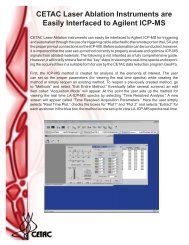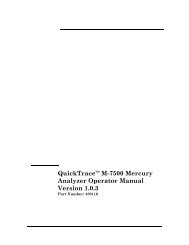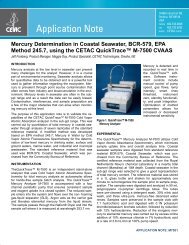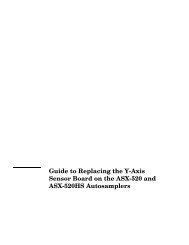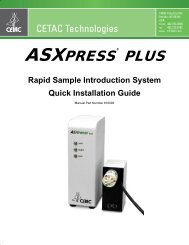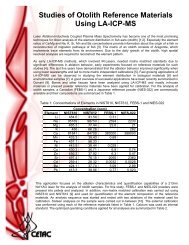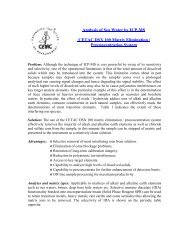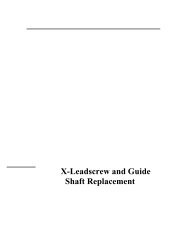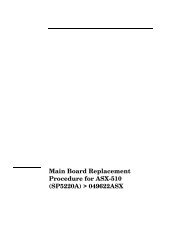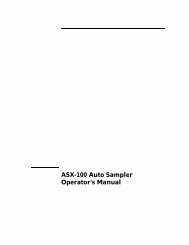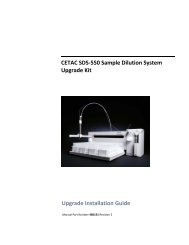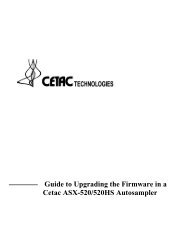CETAC M-7600 Mercury Analyzer Operator's Manual
CETAC M-7600 Mercury Analyzer Operator's Manual
CETAC M-7600 Mercury Analyzer Operator's Manual
You also want an ePaper? Increase the reach of your titles
YUMPU automatically turns print PDFs into web optimized ePapers that Google loves.
Operator’s <strong>Manual</strong><br />
Chapter 4: Using the <strong>Analyzer</strong><br />
NOTE<br />
The <strong>CETAC</strong> QuickTrace M-<strong>7600</strong> mercury analyzer measures inorganic mercury<br />
(free Hg 2+ or HgCl 2 , which is subject to efficient stannous chloride reduction in<br />
the QuickTrace M-<strong>7600</strong> tubing reactor). Inorganic mercury standard solutions<br />
are used for instrument calibration. If insoluble mercury, bound mercury, or<br />
organomercurials are present in samples, an appropriate sample<br />
dissolution/digestion procedure will have to be employed to convert these<br />
forms to free inorganic Hg 2+ or HgCl 2, prior to analysis with the QuickTrace M-<br />
<strong>7600</strong>. If it is desired to confirm the oxidative digestion procedure accuracy<br />
(recovery) regarding organomercurials, then organomercurial standards or<br />
appropriate standard reference materials would have to be carried through the<br />
digestion as “process standards”.<br />
WARNING<br />
ORGANOMERCURIAL EXPOSURE HAZARD<br />
The handling of organomercurial concentrates, which may be used in the<br />
preparation of process standards, presents a substantial (potentially lethal)<br />
safety hazard. Only an experienced, professionally trained organo-metallic<br />
chemist, knowledgeable and skilled specifically in the safe handling of<br />
organomercurials (using approved apparatus and approved protection<br />
measures in an approved facility) should attempt to prepare diluted<br />
organomercurial process standards from concentrates. Always be sure to<br />
obtain and carefully read the MSDS (Material Safety Data Sheets) before<br />
handling organomercurials!<br />
Always wear appropriate personal protective equipment when operating<br />
the mercury analyzer or handling organomercurials. At a minimum, you<br />
should wear eye protection, acid-resistant gloves, and a lab coat.<br />
NOTE:<br />
<strong>CETAC</strong> Technologies assumes no liability for the handling of organomercurial<br />
concentrates or the preparation, handling, or use of diluted organomercurial<br />
process standards.<br />
In most cases, <strong>CETAC</strong> Technologies recommends that samples be oxidized<br />
following standard, safe, well known, approved sample dissolution or digestion<br />
procedures, and that the QuickTrace M-<strong>7600</strong> instrument calibration<br />
standards be prepared only from inorganic mercury concentrates or diluted<br />
from commercially available inorganic mercury standard solution<br />
concentrates. Where possible, the recommended means of overall process<br />
(dissolution/digestion + QuickTrace M-<strong>7600</strong> analysis) validation should be<br />
through use of commercially available standard reference materials (SRM’s) of<br />
composition matching (or similar to) the samples and containing certified,<br />
known mercury levels in a concentration range similar to the samples. (Being<br />
by far the safest alternative, this SRM approach to overall process validation<br />
should be used whenever possible, and is nearly always preferred to preparing<br />
diluted process standards from hazardous organomercurial concentrates!)<br />
80



